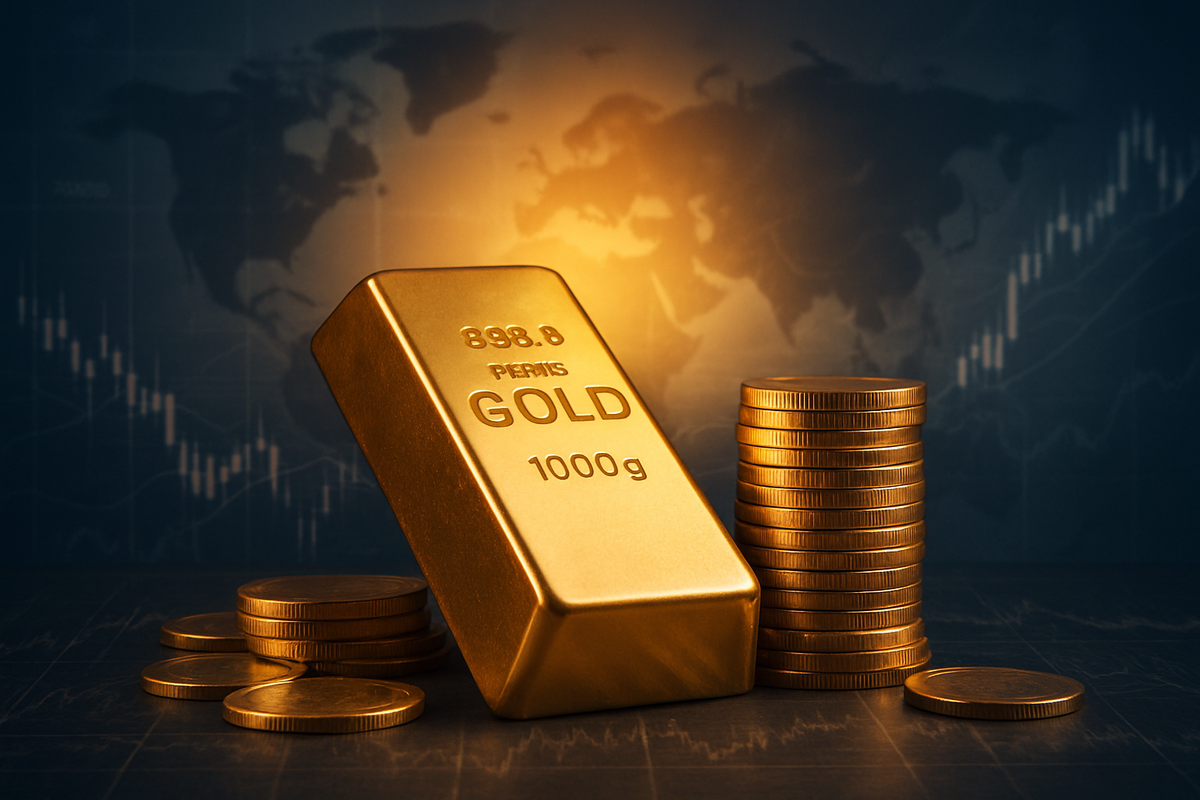
Gold has soared to unprecedented record highs on October 6, 2025, with spot gold touching nearly $3,958.57 per ounce and December Comex futures reaching $3,973.70 per ounce. This monumental rally, which has seen the precious metal gain almost 50% year-to-date, is a direct reflection of a global flight to safety, escalating expectations for central bank interest rate cuts, and aggressive accumulation by central banks worldwide. The immediate implication is a significant re-evaluation of gold's role as a primary safe-haven asset and a critical component for portfolio diversification in an increasingly volatile global economic landscape.
The surge underscores deep-seated anxieties within financial markets, driven by geopolitical tensions, a prolonged U.S. government shutdown, and broader economic uncertainties. As investors seek refuge from market turbulence and potential currency devaluations, gold's allure as a secure store of value has intensified, pushing its price into uncharted territory and signaling a potentially prolonged period of elevated demand.
Gold's Ascent: A Confluence of Global Factors
The remarkable ascent of gold to record highs on October 6, 2025, is attributed to a powerful combination of macroeconomic and geopolitical factors that have converged to create an ideal environment for the precious metal. Spot gold's peak at $3,958.57 per ounce and December Comex futures hitting $3,973.70 per ounce represent a culmination of sustained buying pressure throughout the year, with the metal achieving an impressive nearly 50% year-to-date gain. This rally has been particularly pronounced in recent months, with gold up 27% YTD by July and 48% by October.
A primary driver of this surge is the heightened investor demand for safety. The ongoing U.S. government shutdown, now entering its second week, has significantly amplified political and economic uncertainty, causing delays in crucial data releases and fueling concerns about its broader impact on the global economy. This domestic instability, coupled with persistent geopolitical tensions—including conflicts in the Middle East, the Russia-Ukraine war, and political unrest in various nations like France and Japan—has propelled investors towards gold as a traditional safe haven. Concerns over central bank independence and mounting sovereign debt issues further contribute to this flight to safety, while a weaker U.S. dollar makes gold more attractive to international buyers.
Adding significant momentum to gold's rally are the pervasive expectations of central bank interest rate cuts. The Federal Reserve's pivot towards a rate-cutting cycle, with the first cut implemented in September, has created a highly favorable landscape for non-yielding assets. Markets are now pricing in a 95% probability of a 25-basis-point cut in October and an 83.7% chance of another cut in December, signaling continued easing throughout 2025. Lower interest rates reduce the opportunity cost of holding gold compared to interest-bearing assets, making it a more appealing investment. This trend is not confined to the U.S., as central banks in Europe and Asia have also initiated rate cuts, contributing to a global environment of declining yields and negative real interest rates that bolster gold's attractiveness.
Perhaps the most impactful, and historically significant, factor is the unprecedented level of central bank purchasing. Global central banks have been aggressively accumulating gold, purchasing a record 1,200 metric tons in 2025—a 40% increase from the previous year. This strategic shift is driven by a desire to diversify reserves away from dollar-denominated assets, a trend amplified by geopolitical tensions and broader de-dollarization efforts. Emerging market nations such as China, India, Poland, Russia, and Turkey have been particularly active buyers. A June 2025 World Gold Council survey revealed that 95% of central banks expect to increase their gold holdings in the next 12 months, with 73% planning to reduce exposure to the U.S. dollar. This collective action has pushed gold's share in sovereign reserves past that of the U.S. dollar for the first time since 1996, indicating a profound and lasting structural shift in global financial architecture.
Corporate Fortunes Shift: Winners and Losers in the Gold Rush
The unprecedented surge in gold prices to nearly $3,950 per ounce on October 6, 2025, is sending ripple effects through various sectors of the financial market, creating clear winners and challenging others. Companies with direct exposure to gold, whether through extraction, investment products, or retail, are experiencing significant shifts in their financial outlooks.
Gold mining companies stand as the most direct and prominent beneficiaries of this rally. For giants like Newmont Corporation (NYSE: NEM), Barrick Gold Corporation (NYSE: GOLD), Alamos Gold Inc. (NYSE: AGI), Agnico Eagle Mines Limited (NYSE: AEM), and Kinross Gold Corporation (NYSE: KGC), higher gold prices translate almost immediately into substantially increased revenues and expanded profit margins. The operating leverage inherent in mining means that even a modest increase in gold's value can lead to outsized improvements in earnings and cash flow. This environment encourages miners to boost exploration budgets, accelerate development projects previously deemed marginal, and even consider reopening older mines, all contributing to stronger balance sheets and often leading to stock price appreciation and increased shareholder returns. Streaming and royalty companies, such as Wheaton Precious Metals Corp. (NYSE: WPM), also thrive, as they acquire future production at fixed, lower costs, benefiting directly from the widening spread with market prices.
Conversely, jewelry retailers face significant headwinds. For major players like Signet Jewelers Limited (NYSE: SIG) and luxury brands such as Tiffany & Co. (NYSE: TIF), the escalating cost of gold directly impacts their cost of goods sold. While some retailers might initially benefit from inventory gains if they hold older, lower-cost stock, the sustained high prices can lead to margin compression if they cannot fully pass on these increased costs to consumers. More critically, higher retail prices often result in reduced sales volumes as consumers become price-sensitive, opting for lighter designs, alternative materials, or postponing purchases. While some organized retailers in markets like India have adapted through exchange programs and promoting 18-karat gold, the overall trend for the sector is one of increased operational costs and potential demand elasticity challenges, which can negatively impact profitability and stock performance.
Financial institutions with robust commodity trading desks and asset management divisions are also among the winners. The heightened volatility and increased investor interest in gold drive up trading volumes across spot, futures, options, and Exchange Traded Funds (ETFs). This translates into higher trading revenues, commissions, and advisory fees for firms like Goldman Sachs, J.P. Morgan, UBS, and HSBC. Moreover, asset managers such as BlackRock (NYSE: BLK) and State Street Corporation (NYSE: STT), which manage popular gold-backed ETFs (e.g., iShares Gold Trust, SPDR Gold Shares), see their assets under management (AUM) swell with rising gold prices, generating higher management fees. Online brokers like Interactive Brokers (NASDAQ: IBKR) also benefit from increased client engagement in gold trading, providing platforms for accessing this surging asset class. The demand for hedging strategies from various companies in the gold supply chain further boosts the revenue streams of these financial intermediaries.
Wider Significance: A Paradigm Shift in Global Finance
The relentless climb of gold to unprecedented highs is far more than a mere market event; it signals a profound paradigm shift in global finance, reflecting deep-seated anxieties and strategic reorientations. This surge fits squarely into broader industry trends emphasizing de-dollarization, inflation hedging, and a renewed focus on tangible assets in an era of digital and geopolitical uncertainty. The historical correlation between gold and other assets is also undergoing an unusual transformation, suggesting a new market dynamic.
One of the most significant trends highlighted by gold's ascent is the accelerating de-dollarization movement. Global central banks, particularly those in emerging markets like China, India, Poland, and Turkey, have been aggressively accumulating gold, purchasing a record 1,200 metric tons in 2025—a 40% increase from the previous year. This strategic accumulation is driven by a desire to diversify reserves away from U.S. dollar-denominated assets, a move intensified by geopolitical tensions, sanctions risks, and concerns about the long-term stability of the dollar as the primary global reserve currency. The World Gold Council's June 2025 survey, indicating that 95% of central banks expect to increase their gold holdings and 73% plan to reduce dollar exposure, underscores a fundamental, structural shift. For the first time since 1996, gold's share in sovereign reserves has surpassed that of the U.S. dollar, marking a historic turning point and suggesting potential ripple effects on the stability of fiat currencies and international trade dynamics.
The regulatory and policy implications of this gold rush are substantial. Governments and central banks are grappling with the implications of persistent inflation, sovereign debt challenges, and the potential for a more fragmented global financial system. The U.S. government shutdown, acting as a catalyst for safe-haven demand, highlights the fragility of political stability and its immediate impact on market sentiment. Policymakers may face increased pressure to address fiscal imbalances and restore confidence in traditional financial instruments to temper the flight to gold. Furthermore, the aggressive central bank buying could prompt discussions around international monetary policy coordination and the future role of reserve currencies, potentially leading to new multilateral agreements or shifts in financial regulations aimed at managing global economic risks.
Historically, gold has served as a reliable hedge against inflation and economic instability, but the current surge presents unique comparisons. While past gold rallies, such as those in the 1970s and early 2000s, were often tied to specific inflationary periods or geopolitical crises, the current environment combines sustained inflation, unprecedented central bank purchasing, and a complex web of geopolitical conflicts. An unusual aspect of the current market is the simultaneous record highs observed in both gold and the S&P 500 (SPX), breaking traditional inverse correlations. This phenomenon, with the correlation reaching an unprecedented 0.91 in 2024, suggests that market participants are seeking safety and growth simultaneously, or that liquidity is so abundant that it is inflating all asset classes. This challenges conventional wisdom about asset diversification and raises questions about the underlying health of the broader market, even as gold shines.
The ripple effects extend to other precious metals, with silver surging to a 14-year high of $48.59 per ounce and outpacing gold with a 63.4% gain in 2025. This indicates a broader safe-haven and industrial demand for precious metals, further solidifying their role in investor portfolios. The sustained bullish sentiment for gold, coupled with the systemic shifts in central bank strategy, suggests that this is not merely a cyclical upturn but potentially a long-term revaluation of gold's fundamental role in the global financial ecosystem.
What Comes Next: Navigating Gold's Elevated Trajectory
The remarkable ascent of gold to new record highs sets the stage for a period of intense market scrutiny and strategic adaptation across the financial landscape. In the short term, the market remains highly bullish, with many analysts forecasting continued upward momentum. Projections from institutions like HSBC anticipate gold trading above $4,000 per ounce, while Goldman Sachs targets a range of $3,750-$4,100, and UBS offers an even more optimistic outlook of $4,200 by year-end. This suggests that the immediate future could see gold test and potentially breach the $4,000 psychological barrier, driven by persistent safe-haven demand and the ongoing expectation of further central bank rate cuts. However, investors should also be wary of technical indicators showing gold in "extremely overbought" conditions, signaling a potential for sharp, albeit possibly temporary, corrections.
In the long term, gold's trajectory appears strongly supported by structural shifts rather than just cyclical factors. The sustained central bank purchasing, driven by de-dollarization efforts and diversification strategies, represents a fundamental re-rating of gold's role as a reserve asset. This institutional demand is likely to provide a robust floor for prices, even if speculative interest wanes. Furthermore, ongoing geopolitical instability, persistent inflationary pressures, and sovereign debt concerns are unlikely to dissipate quickly, ensuring that gold retains its appeal as a hedge against systemic risks. Potential strategic pivots for investors and institutions include increasing portfolio allocations to gold, with some experts recommending 5% to 10% for diversification, and exploring investment opportunities in well-managed gold mining companies with strong balance sheets and low production costs.
Market opportunities are emerging not just in physical gold or gold ETFs, but also in the broader precious metals complex, as evidenced by silver's significant gains. This could lead to increased investment in silver, platinum, and palladium, which often follow gold's lead but also possess strong industrial demand drivers. Challenges include managing the risk of volatility and potential profit-taking, especially if economic data improves unexpectedly or if central banks signal a pause in rate cuts. A stronger U.S. dollar, or a resolution of major geopolitical conflicts, could also serve as headwinds.
Several scenarios could unfold. In a bullish scenario, continued global uncertainty, aggressive central bank buying, and deeper rate cuts could propel gold well beyond $4,200, potentially establishing a new, higher baseline for the metal. A more tempered scenario might see gold consolidate around the $3,800-$4,000 range, experiencing periodic corrections but maintaining an overall upward trend. A bearish, though less likely, scenario would involve a rapid resolution of global conflicts, a surprisingly robust global economic recovery, and a hawkish pivot by central banks, leading to a significant pullback. However, given the current confluence of factors, the overarching sentiment points towards gold maintaining its elevated status as a critical asset in the evolving global financial landscape.
Wrap-Up: Gold's Enduring Significance in a Changing World
The historic surge of gold to unprecedented highs on October 6, 2025, is a defining moment for financial markets, underscoring a profound shift in investor sentiment and global monetary strategy. The key takeaways from this event are multifaceted: gold's undeniable reassertion as the premier safe-haven asset, the powerful influence of central bank rate cut expectations, and the structural impact of aggressive central bank diversification away from traditional reserve currencies. With spot prices nearing $3,958 per ounce and a year-to-date gain of nearly 50%, gold's performance reflects deep-seated anxieties about geopolitical instability, economic uncertainty, and the long-term implications of sovereign debt.
Moving forward, the market is poised for continued vigilance. Gold's elevated status is likely to persist, supported by the ongoing U.S. government shutdown, persistent global tensions, and the continued dovish stance of central banks. While some technical indicators suggest overbought conditions and the potential for short-term corrections, the fundamental drivers—particularly the strategic accumulation by central banks—provide a robust long-term bullish outlook. This period marks a significant re-evaluation of gold's role, not just as a hedge against inflation or currency devaluation, but as a cornerstone of national reserves and a vital component of diversified investment portfolios.
The lasting impact of this gold rally will likely be a more diversified global financial system, less reliant on a single reserve currency, and a heightened appreciation for tangible assets. Investors should watch closely for central bank pronouncements on interest rates, developments in geopolitical hotspots, and any shifts in the U.S. dollar's strength, as these factors will continue to influence gold's trajectory. Furthermore, monitoring the performance of gold mining companies and the inflows into gold-backed ETFs will provide insights into sustained market confidence. In an increasingly complex and uncertain world, gold has once again proven its enduring significance as a beacon of stability and a store of value.
This content is intended for informational purposes only and is not financial advice


















